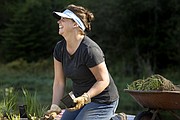On an island
HAYDEN LAKE - Picture a day when tiny man-made islands float near Hayden Lake docks, gobbling up excess nutrients suspended in the water and converting that pollution into fish food.
Members of Kootenai Environmental Alliance are working to make that happen. KEA and some property owners on the lake's McLean's Bay launched a couple of those islands on Thursday. They don't call them islands, though, but "floating treatment wetlands."
The work is part of the Hayden Lake Project, which started in 2009 and operates under the direction of KEA. The natural-looking floating wetlands technology isn't new, but it's new to North Idaho.
"These are basically floating, fish-food buffets," said Adrienne Cronebaugh, KEA's executive director. "(The fish) load the phosphorus into their bodies and people fish them out."
The water quality will be assessed regularly around the wetlands to determine how well they're working.
Thomas Lawrence, a property owner on Hayden Lake at McLean's Bay, said, "If the bay goes bad, then that obviously effects property values."
He's anxious to see the floating wetlands in action.
"You can tell where the water, even today, is cloudy," Lawrence said. "And in the warm time in the summer it's even cloudier."
A big part of the lake's problem is it doesn't have an outlet, such as Lake Coeur d'Alene has with the Spokane River.
The suspended material absorbs more heat in the summer, increasing water temperatures and decreasing important dissolved oxygen levels in the process.
Karen Hayes, a biologist who is on KEA's board of directors, tested one of the floating wetlands on a nutrient-loaded 1-acre settling pond on her property near Hayden Lake.
"It is working in my pond," she said. "The numbers are beginning to show some progress."
Some municipalities have adopted the technology for water treatment, such as Los Angels County, Hayes said.
The floating wetlands can be nearly 200 times more powerful than natural wetlands, and once in the water they can be easily pulled from one area to another as needed, Hayes said.
The man-made versions start with a spongy, porous plastic base made of recycled plastic bottles.
The buoyant foundation is planted with sod and native wetland plants, and the roots grow through the base and extend down into the water and soak up excess nutrients. Any plants, flowers or vegetables can grow on the wetlands.
The plants on the wetlands don't decompose in the lake and give the nutrients back, like aquatic plants do.
The submerged portions of the wetlands will provide surface area for a filmy material called periphyton, a fish food, to grow.
"We have other lake associations who are in trouble who are watching this project really closely," Hayes said, referring to Twin Lakes and Fernan.
KEA has become a distributor of the wetlands, and can sell them for a reduced price. The group's representatives also can help owners of new wetlands prepare them for launch, Cronebaugh said.
KEA information: (208) 667-9093





